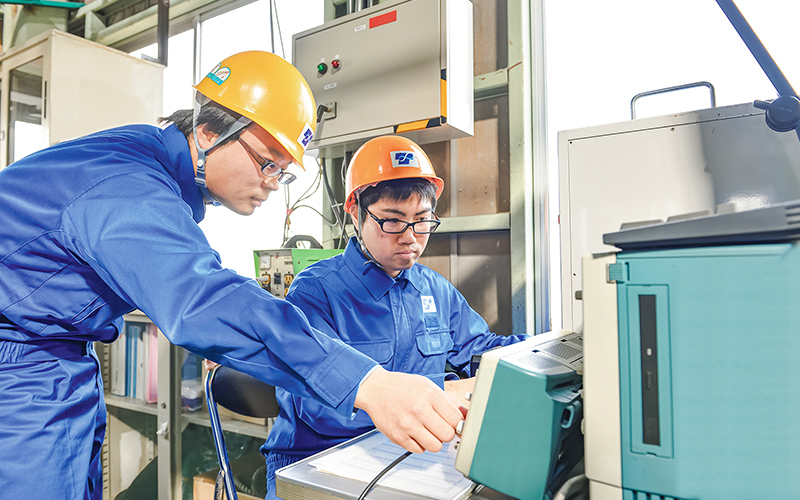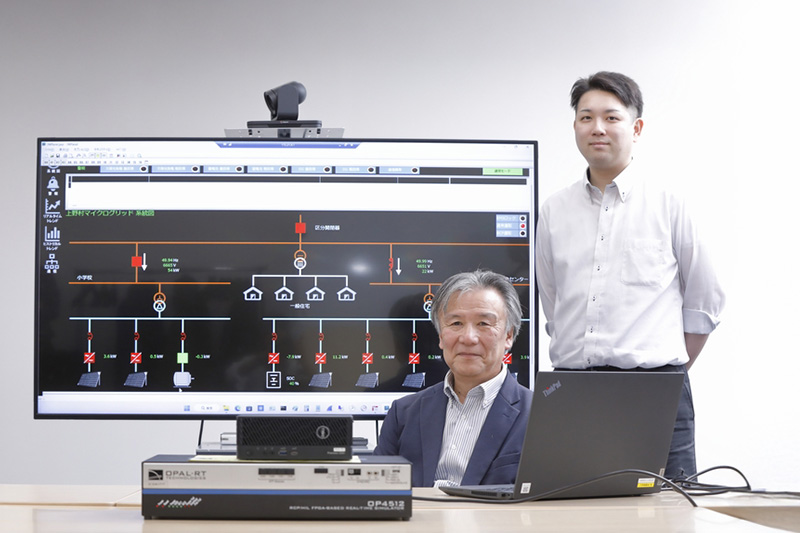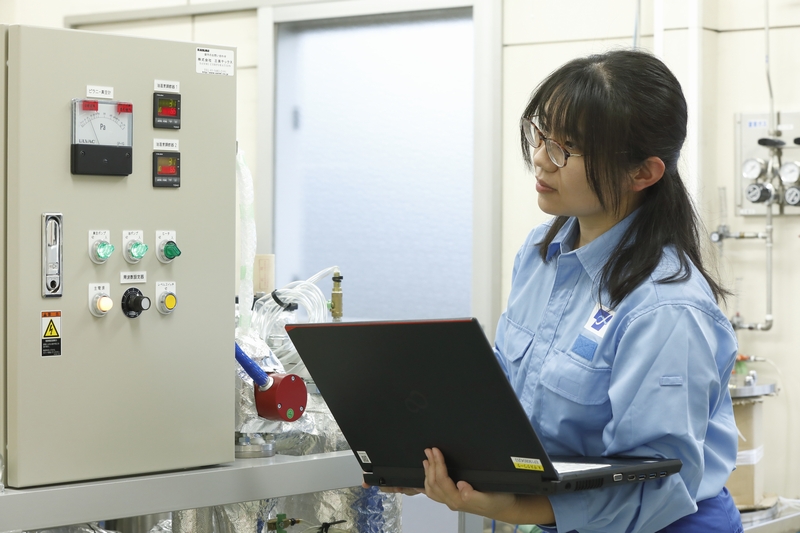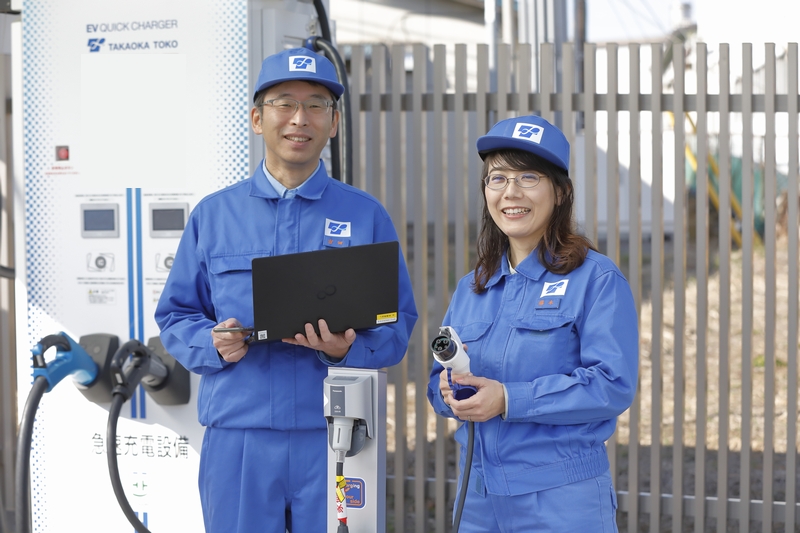Investigation of Evaluation Method of Lightning Impulse Insulation Characteristics by Oil Immersion Element Model of Transformer Winding
- Tomoaki Yoshimura
- Takayuki Sakai

Our product development follows our business roadmap. This roadmap also includes technical development related to product development, and extracts various technologies required for product development. The development of elemental technology, which is the most fundamental of new technology development projects, is the basic research that our group conducts.
We are currently researching insulation characteristics in the elemental technology of oil-immersed transformers. For example, transformers must be designed to withstand lightning strikes. To do so, we need technology to grasp the voltage inside the transformer when it is struck by lightning, technology to suppress it, and technology to withstand that voltage. Various researches combining experiments and analyses on these insulation technologies have been conducted, and the results of them have been linked to the improvement of transformer reliability. In our research on transformers, we are working to gather opinions not only from within the company but also from external experts, and are proceeding within a broad knowledge network. While maintaining high reliability through this research system, we are working to rationalize insulation characteristics in order to meet the needs of design departments for cost reduction and compactness of products. We will introduce our efforts toward this.
Technology
Element model test using lightning impulse that considers insulation characteristics and contributes to further rationalization of insulation design
When electric power is delivered from a power plant to each household, a portion of the electric power becomes heat due to the electrical resistance of transmission lines, etc., resulting in loss. In order to reduce this loss and transmit power, it is desirable that the voltage be as high as possible. On the other hand, plants and ordinary homes that use electricity must have a low voltage that is easy to handle. Transformers are used to convert power to the appropriate voltage when delivering power from power plants to homes. Transformers used to transmit electric power cannot be damaged by assumed natural disasters and are therefore designed to withstand high voltages such as lightning strikes. If a transformer breaks down due to a lightning strike, etc., it will lead to power outages in plants, buildings, and homes that use electricity.
The contents of the oil-immersed transformer consist of a transformer body that combines an iron core with two or more windings, and insulation oil that enhances insulation strength and cooling effect, which is housed in a tank. Among them, the winding, which is the heart of the transformer, achieves insulation with a composite structure that combines paper, an insulator, with insulating oil. Due to the lightning strike mentioned earlier, a large voltage is generated between the wires of this winding. Breakdown of the insulation due to this large voltage will lead to breakdown. Therefore, this insulation is the most important elemental technology for transformers. In our research, regarding this insulation, we create an insulation element model for each part and perform a test called a lightning impulse test, in which a high voltage is applied to the model to simulate lightning. In addition to obtaining information such as dielectric breakdown characteristics from this test, we are also considering insulation characteristics in combination with theoretical formulas and electric field analysis. The results of this research are reflected in product design, and we are working to reduce the cost and make the equipment more compact while maintaining and improving the insulation performance.

Profile
-
 Tomoaki YoshimuraTechnology Development Division
Tomoaki YoshimuraTechnology Development Division
Research and Development Center
Computer Analysis & High Power Testing Group -
 Takayuki SakaiTechnology Development Division
Takayuki SakaiTechnology Development Division
Research and Development Center
Computer Analysis & High Power Testing Group
Use test results to reduce product costs
Yoshimura: I joined the company in 2011. From the time I joined the company until 2014, I was involved in the design of transformers. After that, I was transferred to the Computer Analysis & High Power Testing Group, where I am working on basic research on oil-immersed transformers.
Sakai:I joined the company in 2017, and have been involved in research on oil-immersed transformers in the Computer Analysis & High Power Testing Group since then.
Yoshimura:Transformers have been almost the same in shape since before, but materials, manufacturing methods, and plant quality-control have changed over the times. In some cases, past test data and verification details cannot be used as they are, so we are once again working on basic research on transformers, and are currently conducting tests and verifications mainly on insulation.
Sakai:In order to study the insulation characteristics of the windings, which play an important role inside the transformer, we conducted tests by applying a high voltage simulating a lightning strike to an element model simulating each part of the windings.
Yoshimura: In our research, we not only acquire completely new data, but also compare it with past test data and accumulate further data to make it more accurate. In addition, we are aiming for a more rational evaluation by incorporating analysis using computer simulation. The ability to analyze and evaluate insulation characteristics obtained through testing contributes to product cost reductions and compactness by, for example, reviewing to appropriate allowable values based on improvements in material characteristics and manufacturing technology.
Sakai:When a transformer of actual size is manufactured for testing, it is expensive and time-consuming, so when it is necessary to acquire a large number of data, a small element model that is easy to handle is manufactured and used for testing. Yoshimura and I are conducting this research together. In addition to getting the cooperation of people at the manufacturing site, however, we also incorporate the opinions of experts such as university professors when we have questions during the verification stage. The professor who taught me at university for three years is very knowledgeable about transformers and electrical insulation, so even after graduating, he has given me a lot of advice through industry-academia collaboration. We have been able to confirm with outside experts that our philosophy is correct, and we have been able to feed back our knowledge and reflect it in our research, which has been a major effect.
Yoshimura:When we don't get the expected test results, we review the test conditions to see if, for example, there were any errors. We are verifying while trying various approaches, including environmental aspects such as temperature.

Interest in getting to know the deeper parts of transformers through research
Yoshimura: It is a great attraction in research to learn about phenomena that have not been known until now through research. At first, I was pursuing optimal design within the standards determined by the design department, but after becoming involved in research, I began to think about why such phenomena occur in the phenomena related to transformers, and my perspective has changed from before. Since I joined the research division, I have been thinking more about the field of transformers, and I feel rewarding because I have discovered a variety of things every day. I will continue to work with the desire to deepen my understanding and improve the quality of our products. At present, the research theme is the request from the design department, but if new issues are found in the course of research, I would like to study them as the next and subsequent themes.
Sakai:Since I joined the company, I have been consistently involved in this research, so at this stage, all of my work at the company is this research. When compared to Yoshimura, who was also involved in the design before, there are some things I don't understand when it comes to the core parts of transformers. However, I feel that it is attractive to be able to take on challenges, e.g., changing existing things by incorporating different perspectives and methods and denying the current situation, while periodically reviewing device design technical standards based on the results of basic research. I believe there is no end to the pursuit of technology and quality improvement. I will study the structure and phenomena of transformers thoroughly and continue research to realize cost reduction and compactness of products.

Latest articles
-
 interviewProposal for new value via the first steel-tower-type full-color rendering illumination in JapanSince July in 2021, Prifoods Stadium in Hachinohe City, Aomori Prefecture has operated LED illumination equipment capable of the first steel-tower-type full-color light rendering in Japan. Takaoka Toko/Kyoya Denki/CADEC specific construction work consortium accepted an order for this equipment from Hachinohe City, and it was completed after nine months of work.
interviewProposal for new value via the first steel-tower-type full-color rendering illumination in JapanSince July in 2021, Prifoods Stadium in Hachinohe City, Aomori Prefecture has operated LED illumination equipment capable of the first steel-tower-type full-color light rendering in Japan. Takaoka Toko/Kyoya Denki/CADEC specific construction work consortium accepted an order for this equipment from Hachinohe City, and it was completed after nine months of work. -
 interviewBuilding a microgrid in Ueno Village, Gunma Prefecture, to Achieve Decarbonization and “Zero” Power Outages During a Disaster.The Sixth Strategic Energy Plan, a national policy, states that renewable energy is a main power source, and there is a need to expand the introduction of local power sources, including renewable energy. In recent years, the number of natural disasters in Japan has been on the increase, and a business continuity plan (BCP) is being emphasized for setting forth the methods and measures in advance to minimize the impact of an emergency and to ensure business continuity and a rapid recovery.
interviewBuilding a microgrid in Ueno Village, Gunma Prefecture, to Achieve Decarbonization and “Zero” Power Outages During a Disaster.The Sixth Strategic Energy Plan, a national policy, states that renewable energy is a main power source, and there is a need to expand the introduction of local power sources, including renewable energy. In recent years, the number of natural disasters in Japan has been on the increase, and a business continuity plan (BCP) is being emphasized for setting forth the methods and measures in advance to minimize the impact of an emergency and to ensure business continuity and a rapid recovery. -
 interviewRecycling technology of transformer oil aiming to achieve carbon neutralityNowadays, the work involved in carbon neutrality and the establishment of a recycling society is essential in business activities. The same trend is observed in the field of transformer oil. The international standard for the quality of transformer oil has been revised; there is now no distinction in quality between new transformer oil and recycled transformer oil (hereinafter “recycled oil”) abroad, which allows them to be treated equivalently.
interviewRecycling technology of transformer oil aiming to achieve carbon neutralityNowadays, the work involved in carbon neutrality and the establishment of a recycling society is essential in business activities. The same trend is observed in the field of transformer oil. The international standard for the quality of transformer oil has been revised; there is now no distinction in quality between new transformer oil and recycled transformer oil (hereinafter “recycled oil”) abroad, which allows them to be treated equivalently. -
 interviewWeCharge: EV charging management system that can be operated in large parking areasEfforts intended to achieve carbon-neutral levels have been made increasingly more often, which requires expansion of the EV charging infrastructure in order to propagate electric vehicles (hereinafter called “EV”).
interviewWeCharge: EV charging management system that can be operated in large parking areasEfforts intended to achieve carbon-neutral levels have been made increasingly more often, which requires expansion of the EV charging infrastructure in order to propagate electric vehicles (hereinafter called “EV”).
